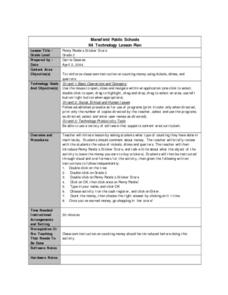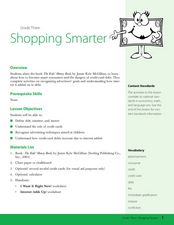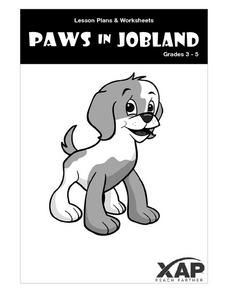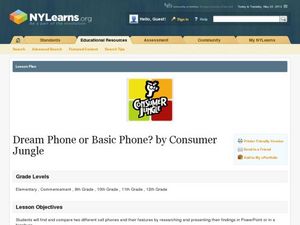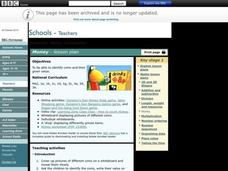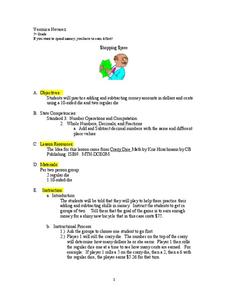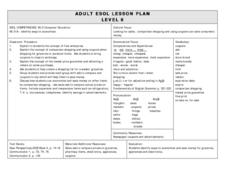Curated OER
Money Matters
Pupils explore the concept of money. In this money instructional activity, students role play an economy. Pupils are divided into three categories- the money factory, construction workers, and the grocery store. Students work...
EngageNY
Random Sampling
Sample pennies to gain an understanding of their ages. The 16th installment of a 25-part series requires groups to collect samples from a jar of pennies. Pupils compare the distribution of their samples with the distribution of the...
Curated OER
Penny Panda's Sticker Store
Second graders practice counting money using nickels, dimes, and quarters. They review the value of nickels, dimes and quarters. They explore Penny Panda's Sticker Store, and talk a little about what the object of the activity is (save...
Curated OER
Lesson 9: Tracking Commodities
Over the corse of a month, small groups will monitor the price of a specific energy commodity and analyze it in relation to global and domestic events. They play a trade simulation game and create infographics showing what they've...
Curated OER
The Big Buck Adventure: Part 2
Students go on a pretend shopping spree. In this money lesson, students complete a Shopping Spree activity sheet where they pretend they have won $100 and can spend it on a fake shopping spree. Students use the Internet to...
Curated OER
Shopping Smarter
Students read a book about money and smart shopping to learn about debt, advertising, and the use of credit cards. For this consumer math lesson, students read the book The Kids' Money Book and discuss economic concepts. Students...
Curated OER
Paws in Jobland: Jobland Shopping Trip
Students gain knowledge of commerce and appreciate the value of money. In this career lesson plan, students role play as storekeepers or shoppers. Students determine where to get the best bargains in their respective roles.
Curated OER
Shopping
In this shopping worksheet, students, with a partner, brainstorm all the words they can think of associated with shopping, discuss thirteen words and phrases associated with shopping and fill in the gaps of four sentences with shopping...
Curated OER
Using Counting-on Strategy for Purchasing
Intended for learners with autism and developmental disabilities, this lesson uses the strategy of counting-on to enhance independent shopping skills. Learners will practice counting on to the next dollar value in order to purchase items...
Curated OER
Home Living/Daily Living: Selecting an Outfit
When people make clothing choices, they should be attempting to buy clothes that are the proper size. Unfortunately, for most that is a skill that they have never been taught. Make sure your special education learners can purchase...
Curated OER
Dream Phone of Basic Phone?
Learning to be a savvy shopper can make or break the bank. Upper graders research five different cell phone carriers to see if they'll have enough money in their imaginary budget for a dream phone or a basic phone. They create either a...
Federal Trade Commission
Ad Awareness
Movie theaters, shopping malls, television, the Internet ... no matter where people go, they are inundated with advertisements. Scholars discuss the topic of ad awareness using the first of four Admongo lessons about advertising. Pupils...
Curated OER
Planning and Shopping for the Menu
Students plan a menu considering the number of people to be served and the amount of money they have to work with to buy the necessary ingredients.
Intel
How Can I Relate?
How much is a million? This unit has a set of lessons investigating large numbers on the order of millions and billions. A culminating project has groups creating a slideshow and poster about large numbers found in the school and/or...
Curated OER
Shopping for Clothes
Learners demonstrate how to request information in a department store. They read and repeat dialogue, role-play with a partner using shopping vocabulary, and write down dictated amounts of money.
Curated OER
Money
Students complete online activities to identify coins and their given values. In this coin values lesson, students identify pictures of various coins and write their values. Students may then complete other activities based on a varying...
Curated OER
Let's Go Value Shopping
Learners count, figure change, and find the value of saving in a classroom store.
Curated OER
It's On Sale
First graders read the book The Great Pet Sale to learn about economics and advertisements. In this economics lesson plan, 1st graders read the book The Great Pet Sale and define related vocabulary words. Students compare prices to find...
Curated OER
Shopping Spree
Sixth graders examine currency by completing monetary equations. In this economics instructional activity, 6th graders participate in a numbers experiment where they roll a die and earn money based on their roll. Students...
Visa
Making Spending Decisions
By role playing real-world experiences, such as purchasing snacks and grocery/toy store shopping, your youngsters will begin to develop an understanding of how to make decisions and choose between alternatives. This is the first...
Curated OER
Money and Banking
Young scholars investigate percents and interest. In this algebra lesson, students invest money in a bank account and calculate the interest rate they receive over time. They convert percents to decimals and solve problems using percents.
Visa
Money Matters: Why It Pays to Be Financially Responsible
What does it mean to be financially responsible? Pupils begin to develop the building blocks of strong financial decision making by reviewing how their past purchases are examples of cost comparing, cost-benefit analysis, and budgeting.
Curated OER
Saving Money On Household Items
Young scholars use sale ads to compare and contrast prices on groceries, electronics, appliances and other goods. Working in groups, students brainstorm ways to save money on these items. This instructional activity is intended for...
Curated OER
Shopping
Fifth graders simulate a shopping experience. Students are given a specified amount of money and they must spend it. Students choose five items they wish to purchase and determine if they can afford the items.




